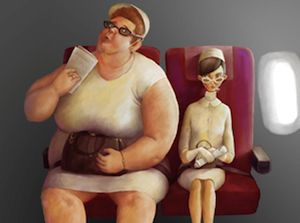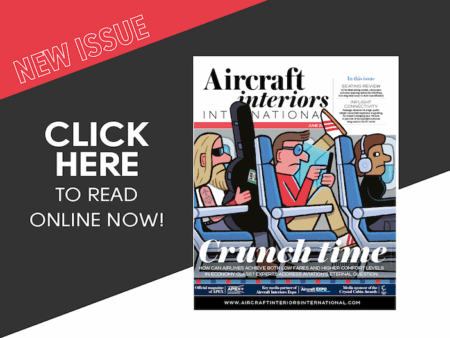Product design and the onboard stage
The onboard stage of the flight journey poses the biggest problem for larger passengers. The main issue, as expected, are the seats. With the size of people ever increasing, it is not surprising that 61% of questionnaire participants believe that bigger aircraft seats will be developed and implemented in the future. However, it is questionable what percentage of seats will be bigger, if these bigger seats should be a separate travel class, and how passengers should be charged for using these bigger seats.
As long as there are more ‘standard size’ passengers than larger passengers, it will be difficult to justify the investments that come with the development of bigger seats. Additionally, the absence of legislation will result in airlines being hesitant to implement changes. However, considering the fact that 42% of UK adults will be obese by 2030, a growing percentage of the airline’s target market will be obese and airlines will potentially lose a large part of their client base if they don’t respond to this trend.
At the moment, larger travellers are forced to purchase two tickets if they are unable to comfortably fit into a single seat. However, this does not entitle them to two meals, or to twice as much luggage, whilst they might actually require more food, and more luggage to carry the same amount of clothes as ‘standard size’ passengers. Also, in a triple configuration, buying two seats means that large people can never sit next to each other, which is undesirable in the case of larger couples or families travelling together.
Additionally, aircraft seats are not designed for larger people, and therefore larger passengers can pose a safety problem for the airline and other passengers. The seats will not respond the way they have been designed to in an emergency situation, because they may be carrying twice the weight or more, and also, seatbelts are not strong enough to keep a large person in place.
When considering all these issues, it can be concluded that there are a number of problems surrounding larger passengers that should be resolved. The obvious solution would be to develop bigger seats for larger people. However, the problem is that airlines will lose capacity, which is economically undesirable. On the other hand, airlines are already losing capacity by forcing larger passengers to purchase two seats. This means that whatever way you look at it, capacity will decrease. Another view is that when airlines are transporting fewer passengers, but are still receiving the same fees from these passengers, this is actually a more beneficial situation for the airline; since they will have fewer passengers to cater for.
The 150% seat concept
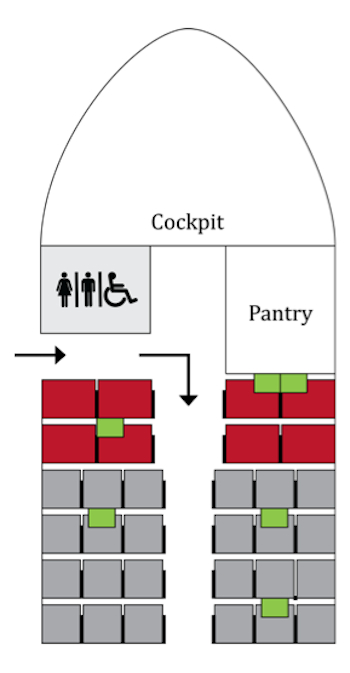
Developing seats that are 1.5-times wider than normal seats would allow larger people to save money on flying. Larger passengers would have to pay the fee for 1.5 seats instead of two, reducing the financial strain on larger passengers, who, according to research, are more likely to have lower incomes to begin with. Subsequently, allowing larger passengers to spend less money on air travel can then be used as a unique selling point for the airline. In addition, this solution would actually reduce the loss of capacity by 50%, when two larger people are seated next to each other on seats of 1.5-times the width, in a row of three seats, as visualised in Figure 12.
This concept allows the seats to be shaped for larger passengers instead of larger travellers having to sit on the ‘shape’ of two seats. Additionally, there is the possibility to make the seats a fraction narrower, allowing slightly wider aisles in between the bigger seats, solving the problem of moving through the aisle for a lot of larger people.
Other advantages include the fact that these seats can be equipped with longer seatbelts naturally and the tray tables are positioned slightly to the side of the passengers in order to offer more comfort and space. Also, positioning the seats near the front of the aircraft allows larger passengers to use the accessible lavatories, eliminating one of the on-board issues.
Disadvantages
A slight disadvantage of this concept is that all bigger seats will need to be located at the front of the aircraft, to ensure larger passengers do not have to move through the narrow part of the aisle. This can result in a separate travel class, or the illusion of a separate travel class, which is undesirable for larger passengers. Larger passengers would prefer to be treated like every other passenger and therefore it would be ideal if the adapted seats could blend in with the other seats.
The main disadvantage of the 150% seat concept is that airlines are risking not having all seats occupied when applying this concept initially. A certain percentage of users need to be obese to ensure users are occupying these seats full-time.
The chair share concept

A possible solution for most of these disadvantages can be found by applying more flexibility. Airlines need to ensure that all flights are fully booked and therefore no empty seats are left on the aircraft. In order to do so, the ‘chair share’ concept can be employed. The chair share concept allows a triple seat to be converted into a double seat and can be used on three different configurations. The seat can be used as a normal triple seat, like all other on the aircraft (see the fourth row of seats on the left side of Figure 13). In the second configuration, one armrest is folded up, allowing one larger passenger and one ‘standard size’ passenger to occupy three seats – as is being done at the moment (see the second row of seats on the left side of Figure 13).
The third configuration allows the two middle armrests to be slid into the middle of the bench, allowing two larger passengers to share three seats, as visualised in the fifth row of seats on the right of Figure 13 and in Figure 14. This solution enables airlines to maximise the commercial use of the aircraft and adjust the capacity of the aircraft to the time of day and route.
The advantages of this concept is the fact that since the triple seat is a bench, the recline function will be eliminated. This reduces the weight of the product because of the reduction of parts. Also, reclining of the seat in front is seen as one of the most irritating aspects of a flight. Additionally, this means that the cabin crew don’t have to check if all seats are in the upright position for take-off and landing.
From the larger passenger point of view, the fact that these seats can be located among the regular seats will make them feel as though they are treated as equally as other passengers. This solution will also allow large couples or families to be seated together.
Disadvantages
Flexibility comes with some slight disadvantages. It requires airlines to match up larger passengers for this ‘chair share’ solution, in order not to miss out on selling the middle seat. A possible solution for this could be to let passengers pick their own seatmates; as KLM is pioneering with its ‘Be My Guest’ scheme.
Additionally, cabin crew need to adjust the configuration of the armrests between flights in addition to their current responsibilities. However, experts believe this is not a big issue since a similar solution is already applied by Lufthansa, and changing a seat’s armrests can be easily done in the turnaround time.
In addition, the concept requires the bench to be ‘unshaped’, meaning it does not have the chair shape that other seats have, reducing passenger comfort. However, it can be argued that because larger people generally have a lower income, they will statistically fly more on short-haul flights, in which instance the decreased comfort will be less of an issue.
It is expected that if either of the above-mentioned concepts are implemented, low-cost carriers (LCCs) will be most likely to be the pioneers, since they have the biggest throughput of people. Also, developments in LCCs happen much faster, since they experience more space restrictions, resulting in more problems and intolerance.
With regard to seats, it can be concluded that the 150% concept provides the most advantages to the airline as well as the passengers. However, this solution will only become viable once there is a guaranteed number of larger passengers on flights and airlines can be certain that the bigger seats will be booked at all times.
Until that time, chair share will offer a flexible solution for the accommodation of larger passengers whilst minimally affecting the airline and other passengers.
Another development which will be to the advantage of passengers is that aircraft manufacturers have learned that people are getting wider, and are creating wider fuselages. Naturally, this will not solve the physical issues that larger passengers are experiencing at the moment, but it will help to accommodate the generally increasing dimensions of the average person.
It is also possible to allow aisle seats to expand into the aisle during flight. However, this would have a negative impact on staff and passengers using the aisle to move through the cabin, and therefore this option is not seen as a viable solution.
To communicate the purpose of the bigger seats to customers, it is recommended to strategically express the purpose of the seat in the name, as is being done with all other travel classes and seat options. Questionnaire participants illustrated two themes when describing the purpose of the seats: comfort and size. It is recommended to link the name of the seats to one of these themes, e.g. Super Economy or Economy Comfort. A generic terminology would be appropriate from an inclusive point of view, because it could also accommodate other extreme users.
Other on-board issues
Apart from the seats, there are some other onboard issues, for which possible solutions will be discussed. Seatbelt extensions pose a more emotional issue for larger passengers. However, when larger passengers are able to request an extension during the booking process, it will avoid them having to request one once onboard the aircraft. Additionally, the need for extensions to be brightly coloured will disappear once staff know exactly how many extensions have been given out and to what passengers, as a result of implementation during the booking process. Another innovation relating to seatbelt extensions is that the standard length of seatbelts for the bigger seats in the 150% seat concept can be increased as to reduce the amount of required seatbelt extensions required.
An additional issue for larger air travellers is the use of the tray table. The table is positioned right in front of the passenger, the place where there is the least space as a result of their body shape. The tables could be positioned slightly more to the side of the passenger, as visualised in Figure 12 – the 150% seat concept. This allows sufficient space for the passenger to sit comfortably in the seat whilst using the table.
Recently, Airbus implemented wider stairs with best practise step designs to aid not just larger passengers, but all staff and passengers on board.
As mentioned previously, the width of the aisles onboard aircraft can be problematic for larger passengers. The 150% seat concept would allow a better solution for this problem; providing a slightly wider aisle at the front of the aircraft.
Lavatories on board the aircraft will be less of a problem in the future when the bigger seats are positioned close to the accessible lavatory, which is a mandatory requirement on all aircraft flying in, to or from the US, since 2009. Aircraft that do not fly to the US might benefit from concepts similar to Boeing’s expanding lavatory, which expands into the aisle/emergency exit during flight, visualised in Figure 14. Airbus also already provides a wide range of lavatory sizes with optional wider doors.
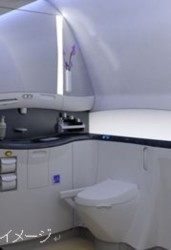
Larger passengers also experience difficulty in placing luggage in overhead storage compartments. Airbus and Boeing have implemented ergonomic luggage storage solutions which minimise the height to lift to increase the comfort of the passenger. This is not just beneficial for the passengers, but for the airlines too, since this design can help to speed up the boarding process and decrease the turnaround time.
The last onboard issue – the location of buttons and headphone plugs on the inside of the armrest – can be easily resolved by applying product design to all seats. It is recommended that a console of buttons and plugs is integrated on the back of the seat in front in order to avoid bringing any discomfort to passengers of any size. Because of this, the interface will be easier to use and as an added benefit for the airline, passengers will not accidentally press the ‘assistance’ button with their upper leg or elbow.
The most important factors for airlines when developing seats are weight and comfort because they directly influence the revenue of the airline. Other important elements are the size, cost and serviceability of the seats. Surprisingly, a lot of effort goes into reducing the weight of the fixed assets – the seats – while the biggest weight variable are the non-fixed assets: the passengers and what they carry on board.
Economics
A member of a leading airline suggested that “maybe someday in the future, passengers and their luggage will be weighed together and charged accordingly”. This idea is also being speculated about by other industry experts and the media.
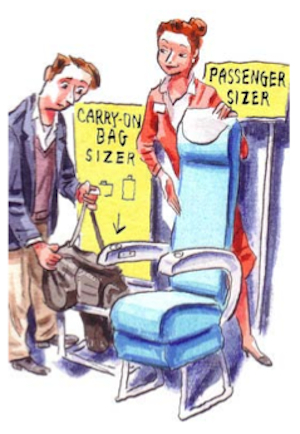
It is a sensitive issue to charge people for their weight, especially since the airline industry is a highly competitive market and therefore airlines need to keep their competitive advantage by offering the lowest possible fares.
The airline representative approached for this research thinks that they will not be designing bigger seats as real estate on aircraft will be very precious, and in combination with the fuel prices going up, focus will be on competitiveness. However, an aircraft manufacturer representative stated that “once airlines discover larger passengers as a business success factor, cabin arrangements will change”.
It is clear that there have not been enough trends and economic studies on the impact that obese passengers will have on the airline industry, and what part of the customer base they represent. On the one hand it is believed that if there is no particular legislation for a certain user group, no developments or changes will be made. However, when it becomes evident that obese people make up a considerable part of the target market, airlines will consider them as part of their business strategy and act on the change in demographics to be able to pioneer in the area and use this as a unique selling point for their brand.
At the moment, passengers are required to purchase two seats or an upgrade when they are unable to comfortably fit in a single seat. This practically results in larger passengers paying 200% for their journey. The developed concepts both provide the option to reduce the charged fee for larger passengers to 150%, but the solutions are different. Experts from both the design and airline industry have expressed concern about how these concepts will be financed.
Charges for concepts
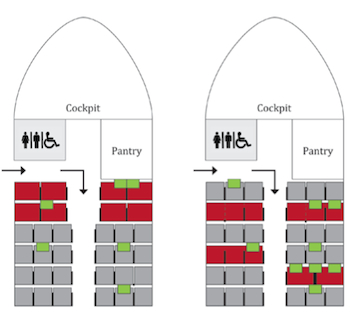
The 150% seat concept involves seats which are 1.5-times as wide as the standard seats (left of Figure 16). This effectively results in passengers being charged 150%. However, as explained previously, this solution will not be viable for another couple of years.
The chair share concept involves benches that offer seating to two or three people at a time. When a larger person wants to travel with this airline, they indicate they need two seats during the booking process. However, this solution provides the option of ticking a box for ‘chair share’. Initially, the passenger is charged for two seats, but if the airline is able to match two passengers requesting a chair share, 50% of the fee for the second seat will be automatically reimbursed to these passengers. This solution results in a flexible option for both the passenger and the airline, guaranteeing that the airline does not lose revenue. There always has to be a commercial aspect to keep a business going, however, it is very important for airlines to be user-centred and passenger focused.
Service design and the flight journey
Apart from the previously discussed booking and on-board issues, some larger passengers also face difficulty walking, climbing steps and standing for long periods of time. 50% of obese questionnaire participants experience difficulty walking, which may result in them using special assistance to make their way through the terminal and onto the aircraft.
Arguably, with the number of obese people rising, the need for special assistance will rise accordingly. This, in time, can become a burden for existing special assistance services and their users. However, airlines pay a fee for special assistance services for every departing passenger, regardless of how many of them require special assistance. This suggests that every passenger is able to use special assistance without having to pay an extra charge.
Unfortunately, as with all business models, the charged amount is most likely based on the relatively small amount of passengers actually using special assistance services. Therefore, if the amount of people using the service rises, the charges will increase.
According to research, obesity is self-inflicted in most cases, and therefore it can be argued that larger passengers would have to pay a small charge for using special assistance, as opposed to disabled passengers who did not ‘self-inflict’ their need for special assistance. However, 50% of questionnaire participants feel that anyone requiring special assistance should get it, regardless of their condition and its origin.
Since the obesity prevalence will only rise further in the future, it can be argued that the name ‘special assistance’ would be inappropriate for larger passengers, since their need for assistance will be increasingly common. Therefore, it might be feasible to develop a new service, using different terminology to separate this growing user group from the disabled passengers. After all, larger passengers are not disabled but experience difficulties. Like pregnant women, they need special assistance but are not disabled.
On the other hand it can be argued that as long as the user group not using any form of assistance is bigger than the group using it, it will remain a special requirement. Therefore, the majority of the questionnaire participants feel that no separate service is required for larger passengers, but that this can be combined with existing special assistance services.
In the future, when the obesity prevalence increases further, a separate service for large passengers with a separate charge might be considered. Until that time, it can be concluded that large passengers can use the existing special assistance services.
Recommendations
Due to all recommendations not having the same priority for execution, Figure 17 visualises in what order the recommendations are advised to be implemented.
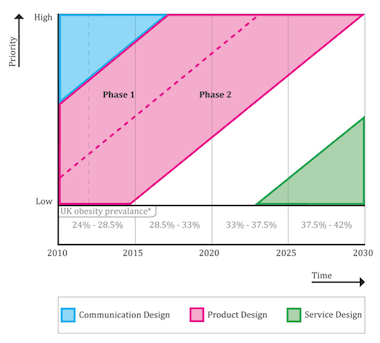
Short term, the implementation of communication design has the highest priority. Communication design is crucial in order to avoid uncomfortable seating, unexpected financial setbacks, and embarrassing situations for passengers and complaints for the airline. The communication design recommendations require a relatively low investment and can be executed immediately, benefitting all stakeholders.
Over the next five years, obesity statistics in the UK are not going to increase dramatically, but the results of the rising obesity prevalence are already starting to show. Airlines that have not already done this are recommended to establish a COS policy. Additionally, in order to communicate the policy to all passengers, it is recommended that the online booking process is redesigned to implement the COS policy and related elements.
Communication design
The redesign entails the implementation of seat quantity on the main page of the ‘flight details’ section of the booking process. This allows passengers to receive accurate price and seat availability information. Additionally, it is recommended that this page contains a link which opens the COS policy in a new window, as to minimally affect the booking process of ‘standard size’ passengers that do not require this information (see Figure 18 and 19).
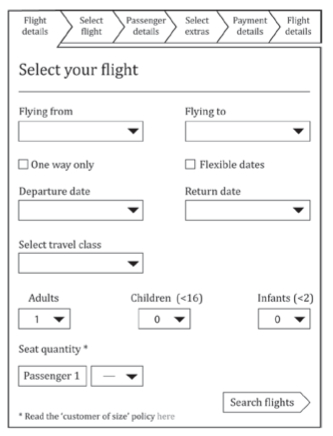
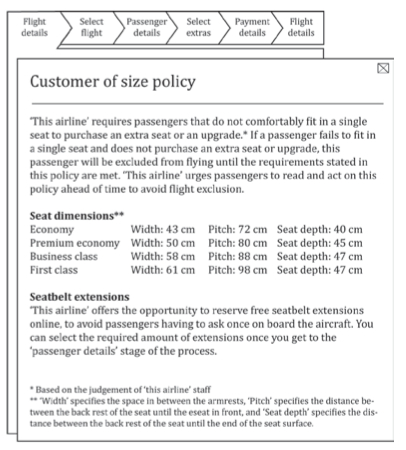
Including the COS policy in the booking process allows all passengers to read the policy and be made aware of the regulations. Firstly, it will inform larger passengers that were previously unaware of the existence of COS policies, and secondly, it creates an understanding among ‘standard size’ passengers. It is recommended for the COS policy to include recommended actions, possible consequences and seat dimensions.
Further on, in the ‘passenger details’ section of the online booking process, passengers will be able to request seatbelt extensions and varying types of special assistance. It is recommended that airlines implement a special assistance menu in the booking process similar to easyJet’s current model, since this is perceived as the best system.
The options to request seatbelt extensions and special assistance are recommended not to be integrated in the main page of the ‘passenger details’ section, but to be included in the ‘options’, along with existing elements, such as dietary requirements and insurance, as visualised in Figure 20.
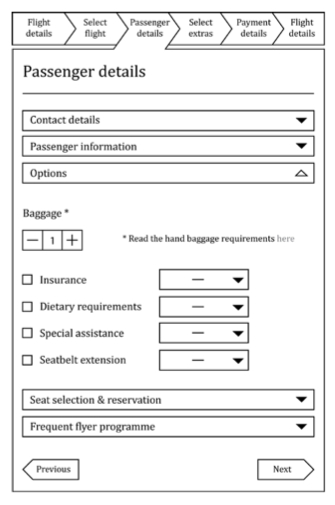
Larger passengers prefer to be treated like all other passengers and therefore prefer to arrange all their requirements online, like everyone else. However, enabling larger passengers to book their tickets through the standard online booking process does not just benefit larger passengers. Airlines will benefit from the reduction in phone calls, resulting in fewer man hours and therefore a cost reduction. Additionally, ‘standard size’ passengers will have a better understanding of the process regarding larger passengers and will be made aware of the fact that the airline is taking the issue seriously.
Additionally, because passengers will book their special assistance requirements online, airlines will be informed of this more than 48 hours before the flight, which is currently the case. This allows the airport operator to have a better overview of the special assistance requirements.
Medium term, it is recommended to apply product design to develop and improve elements of the aircraft interior. Product design becomes a priority when the number of obese people increases and accommodating larger passengers based on policy alone is no longer sufficient. The product design recommendations require a high investment, and both solutions require around three years to be developed. However, the airline implementing the recommended improvements will be able to use this as a unique selling point and possibly attract a growing market share of large people.
Product design
It is recommended to develop two strategic seating solutions for the accommodation of larger passengers. The chair share concept is recommended to be implemented during stage 1 and the 150% seat concept during stage 2 of the priority implementation model in Figure 17.
This concept offers a triple seat, which can be used in three configurations as visualised below in Figure 21. The concept seats either three ‘standard size’ passengers, one ‘standard size’ and one large passenger, or two large passengers.
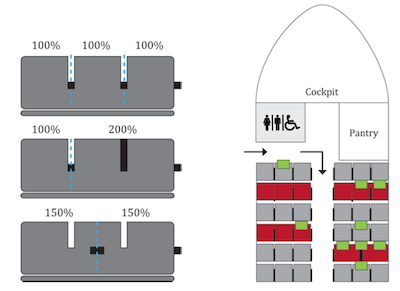
This solution offers complete flexibility for airlines and a potential price benefit for larger passengers. Passengers who require two seats get the option of ticking a box that offers a ‘chair share’ for the middle seat. Passengers initially get charged for two seats, but when they are matched up to another person to share the middle seat with, half the fee of the second seat will be automatically reimbursed, guaranteeing that the airline does not lose revenue. It is a flexible solution that enables larger people to sit together whilst enabling the airline to maximise the commercial potential of the aircraft.
Advantages of this concept are the elimination of the recline function, reducing the weight of the seats, and eliminating one of the most irritating aspects of flying. Additionally, this means that staff don’t have to check if all seats are in the upright position for take-off and landing. Also, the fact that these seats can be spread among the regular seats will communicate equality to larger passengers and make them feel more at ease.
The main disadvantage is that this solution only targets the seat width problem that larger passengers experience onboard the aircraft. Additionally, cabin crew are responsible for changing the configuration of the seats between flights.
When the obesity prevalence rises to about 30% in 2018 (see Figure 17) it is recommended to develop and implement the 150% seat concept of the product design recommendations. Until that time, the chair share concept can be employed and airlines can market this innovation as an unique selling point.
The second stage of the product design recommendations involves another seat development. The reason this development is implemented later than the chair share concept is that a certain percentage of the customer base needs to be obese in order to guarantee there is no loss of revenue for the airline. This incremental form of innovation is beneficial for all passengers as well as the airline.
This concept involves replacing a triple seat with a slightly narrower double seat, enlarging the aisle width simultaneously, as shown in Figure 22. The 150% seats will be located at the front of the aircraft as to avoid larger passengers having to move through the narrow part of the aisle and positioning the seats near to the accessible lavatory on board. These seats will be provided with lengthened seatbelts, reducing the need for seatbelt extensions. Additionally, tray tables are located slightly more to the side of the passenger, enabling larger people to comfortably use the tables. Passengers occupying the 150% seats will be charged the price of 1.5 seats, saving them 25% on having to pay for two seats.
The 150% seat concept, stage 2
The advantage of this concept is the permanent setting of the seats, relieving cabin crew of the task to change configurations between flights. Also, this solution targets more than just the seat width issue that larger people experience. It also improves complications regarding aisle width, lavatories, tray tables and seatbelt extensions.
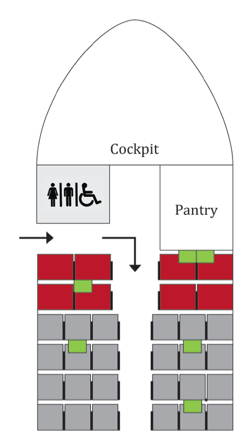
The main disadvantage of this concept is the location of the seats in a different section of the aircraft, which may result in larger passengers feeling discriminated against. However, in case of an emergency it is a safer solution for airlines to position larger passengers close together instead of throughout the aircraft.
It is recommended to replace a percentage of ‘standard’ seats with 150% seats by 2018. However, a combination of the chair share and 150% seats can be employed to offer more flexibility to the airline. Additionally, when implementing the different seating solutions provided, it is recommended that that airlines, as part of the COS policy, offer to reimburse larger passengers for their second seat if the flight is not fully booked.
Long term, the implementation of service design becomes increasingly important. However, this will only be beneficial to implement when the obesity prevalence rises above 50%, meaning that around 25% of passengers will require special assistance because of their size. The service design requires a relatively low investment, and initiating a separate service for larger people will be more accepted by 2040, since obesity will be increasingly common (see Figure 17).
When the obesity prevalence rises, the fee that airlines pay for special assistance services will increase as a result of more passengers using that service. By 2040, obesity will be increasingly common by 2040; therefore the name ‘special assistance’ will no longer apply to larger passengers. It can be considered to develop a parallel assistance service for larger passengers. From a business point of view, airlines might consider charging larger passengers for using this service since, arguably, they inflicted the need for this service upon themselves. As a result, the existing special assistance for all other passengers can remain free of charge.
Validation
Most experts, interviewees and questionnaire participants agree that the implementation of the COS policy in the booking process would benefit all stakeholders.
Airline industry experts feel that developing a new seat for a relatively small target group is a risk because of the relatively big investment required. However, design industry experts argue that if a business case can be made to justify the investments, there is a definite reason to implement the recommendations. Additionally, some questionnaire respondents argued that a flexible solution regarding seating is the way forward to improving the on-board stage the flight experience for larger passengers. At this moment in time it is difficult to argue whether or not the 150% seat concept is a good solution for 2020-2025, since this is too far into the future and experts do not believe that the obesity prevalence will actually rise to the predicted numbers.
Service design recommendations are hard to validate at the moment since this involves developments 20 years into the future. One respondent did mention however, that services need to be sustainable, so therefore when the number of users increases action needs to be taken.
Conclusion
Short term, it is recommended that airlines redesign the booking process to implement the COS policy and related elements. This ensures that larger passengers are made aware of the policy and enables them to book the right amount of seats, as well as to request special assistance and seatbelt extensions online. Allowing larger passengers to book all their requirements online eliminates embarrassment and them having to call the airline. Implementing the COS policy in the booking process benefits the airline because it will create a better understanding of the policy amongst other passengers and reduce the amount of calls, staff and costs.
Medium term, it is recommended that two sets of seating are developed to accommodate larger passengers according to obesity prevalence. This benefits larger passengers because it possibly results in a cost benefit when compared to booking two tickets. ‘Standard size’ passengers benefit because the risk of a large person impeding on their space is reduced, and the airline benefits because it can use the new seating as a unique selling point to attract a growing group of larger travellers and eliminate complaints from passengers.
Long term, airlines might consider developing a separate assistance service for larger passengers to avoid extra charges occurring on special assistance services for disabled passengers.
Lastly, it is recommended that the airline redesigns the customer experience to match the developed and improved touch points across the flight journey, communicating the consistency of all design work.
A combination of strategic communication, product and service design are utilised to improve the flight experience of larger aircraft passengers by recommending developments and improvements on a range of products and services.
Limitations and recommendations for future research
Due to the limited time and resources available for this study, it is recommended that the questionnaire findings are verified with a bigger sample, of both larger and ‘standard size’ passengers. Additionally, because of the limited access to informed interviewees it is recommended to obtain views from stakeholders that are not integrated in the research at the moment such as engineers or financial strategists.


